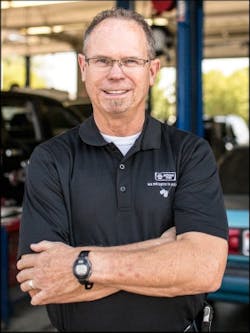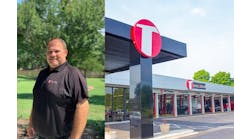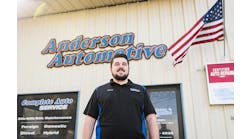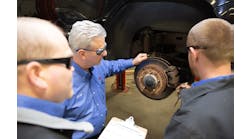SHOP STATS: Garry’s Automotive Location : Boise, Idaho Size: 4,000 square feet Staff: 12 Average monthly car count: 350 Annual revenue: $2 million
It was the culmination of everything he had spent decades of his career working toward: As Garry Plimmer stood in his brand-new, intricately designed, state-of-the-art facility, he believed the 4,000-square-foot building would help take his three-employee, $460,000-per-year business to the next level. After years of renting small facilities, Plimmer was ready to “put on his management cap,” as he calls it, and begin aggressively growing his business.
What he didn’t anticipate, however, was just how much the business would grow—and that his once-spacious new building would soon feel tight and cramped, forcing him to turn to unique and creative ways to maximize his shop’s layout for ultimate throughput.
“Nobody foresees down the road that they’re going to need that space,” he says. “You think, ‘There’s no way we’re going to see those kind of numbers.’ Well, yes, if you do things the right way, you are going to need to be able to handle more volume.”
THE BACKSTORY
By 2005, the shop had reached annual sales of $460,000 and an annual car count of 1,900. Tired of renting different properties, Plimmer purchased a lot on a busy road and worked with an architect to build a facility that encompassed everything he was looking for in a shop.
THE PROBLEM
While there were numerous advantages to the new property—Plimmer had an acre to work with, more than 75 parking spaces and great visibility—one of the biggest hurdles was city laws that restricted the shop floor to 3,500 square feet and seven bays, and the office space to 500 feet.
While that space initially seemed sufficient, at the end of the first year in the new building, sales had grown to $835,000 and he was up to four technicians and two service advisors. By year three, he broke $1 million in sales. While he was thrilled with the numbers, Plimmer realized he was quickly running out of space—without the option to expand on his existing property.
Calculating Facility Utilization
While the calculation for facility utilization is a proprietary RLO Training formula, the calculation takes into account a shop’s number of bays, bay-to-technician ratio, service advisor-to-technician ratio, technician productivity and efficiency, and sales per bay. RLO trainer John Wafler says if a shop is optimally staffed and working at peak efficiency, the shop should produce more than $25,000 in parts and labor sales per bay per month, which results in 100 percent facility utilization.
THE OPTIONS
Plimmer didn’t want to open a second shop or move locations. Getting another facility is easy, he says, but the real challenge lies in replicating the team and the culture he’s built over the years.
Plimmer’s property is located next to several commercial buildings, so he decided that, if needed, he would rent one of the commercial facilities as overflow and eventually build a second building on the property.
However, before resorting to that, Plimmer wanted to focus on truly maxing out his current facility and experimenting with innovative processes to create efficiencies.
THE SOLUTION
To create more efficiencies, Plimmer worked with his team, his business coach and his Bottom Line Impact Group (BLIG) to institute several processes designed to increase sales per bay out of limited space:
Seriously consider equipment purchases. Because of limited space, there’s little room for clutter. Before purchasing new equipment, Plimmer and his staff meet to discuss frequency of use and which existing piece of equipment will inevitably be removed to make room. If there is a utilization concern, Plimmer will look for alternatives, such as borrowing the piece of equipment from a fellow NAPA Business Development Group member.
“There’s no sense in all of us going and buying one piece of equipment we’re going to use one time,” he says. “Could we get it from our neighbor? Sometimes the answer is yes. That seems to work out quite well.”
Hire a shuttle driver. With such a small waiting room, Plimmer doesn’t want customers waiting while their vehicles are repaired. That’s why he hired a full-time shuttle driver to drive customers. If the shuttle driver is too busy, Plimmer will act as a backup. And if needed, the shop created a professional-looking lunch room upstairs to ensure the rare waiting customer is comfortable, too.
In addition to driving customers, the shuttle driver is also responsible for sweeping and mopping bays after a technician moves a car out of the bay. “You can imagine how efficient you get when you’re doing that,” Plimmer says. “All you have to do is a quick test drive, drop off some paperwork, get the next car, drive back into a clean bay and it’s ready to go.”
“If you can hit those kind of numbers out of a facility of this size, then hallelujah!” —Garry plimmer, Owner, Garry’s Automotive
“Sometimes there are two ‘Chatty Cathys’ next to one another and they start chatting more than they should,” he says. “Then everyone will rotate. We’re just always looking for a good combination and even a good combination turns bad over time.”
Cultivate a team environment. Plimmer wanted to create a strong culture that promoted teamwork in the shop, so technicians are paid flat rate. He spends significant money on employee benefits and team bonding events, and also emphasizes weekly team meetings.
He says it’s resulted in a team-oriented environment where technicians don’t think twice to help each other out. For example, when a technician pulls a vehicle into a bay, he’ll honk the horn and another technician will come over, shut the bay door and begin giving him updates on various lights on the vehicles. It’s 15 seconds worth of feedback, Plimmer says, but it saves significant time from having to do it yourself.
“That way we can take care of all our customers’ oil change needs without spending too much time on them, which doesn’t generate the revenue that we hope for and frustrates our technicians,” he says.
THE AFTERMATH
After implementing those processes, sales rose by $150,000 every year and now rest at $2 million with an average monthly car count of 350. On the shop floor, productivity rests at 98 percent, facility utilization is 116 percent [on Page 73] and gross sales per technician are $35,000—some of the highest in his BLIG.
“I think that’s a pretty good accomplishment,” he says. “If you can hit those kind of numbers out of a facility of this size, then hallelujah!”
THE TAKEAWAY
Plimmer says that getting more out of a small space comes down to being creative, embracing training, honing your staff’s skills and constantly striving for improvement.
“We grew rapidly because we figured out how to make everything flow,” Plimmer says. “[The staff] knows how it works and they become very efficient. We’re always trying to improve. We’re not locked into anything. If there’s a better way to do things, let’s take a look at it.”



